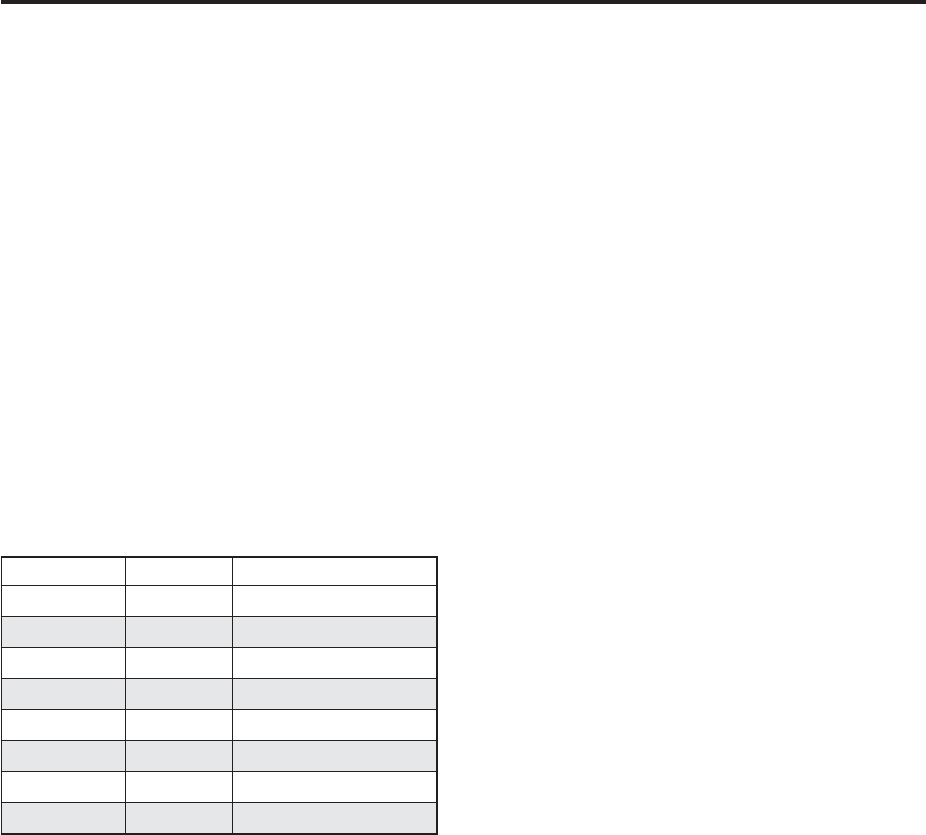
EXi: STR-1 Plucked String
250
Use Excitation Position [Check-box]
This makes the harmonic use the same position as the
excitation, including AMS modulation. Using this
option creates an interesting hybrid pluck/chime
timbre.
When this is checked, the rest of the Position
parameters will be grayed out.
Position [0…100.0]
This controls the position at which the string is being
pressed down. As when playing harmonics on a real
string, the harmonic will be loudest when the position
aligns with the harmonic series.
When the Harmonic Tracking Mode is set to
Keyboard, it’s easy to make the position match a
specific harmonic, as shown below. When Tracking
Mode is set to String, the values below are correct for
the open-string notes only; on other notes, the
harmonics will line up with slightly higher values.
Harmonic Position and the Harmonic Series, when Tracking
Mode = Keyboard
If Use Excitation Position is On, this parameter is
grayed out.
AMS [List of AMS Sources]
This selects a modulation source to control the
Position. For a list of AMS sources, see “AMS
(Alternate Modulation Source) List” on page 967.
If Use Excitation Position is On, this parameter is
grayed out.
Intensity [-100.0…+100.0]
This controls the depth and direction of the Position
modulation.
If Use Excitation Position is On, this parameter is
grayed out.
Tracking Mode [String Track, Keyboard]
This controls the relationship between the harmonic
Position and the pitch.
String Track scales the position according to the
current String, as set in the String Track section.
Keyboard scales the position according to pitch,
without taking the String settings into account. This
might be more appropriate for clav sounds, for
instance.
If Use Excitation Position is On, this parameter is
grayed out.
Pressure [0.0…100.0]
This controls how hard the string is being pressed
down. Non-zero settings can create interesting special
effects–but for standard use, this should be left at 0.0,
and then modulated via AMS. For instance:
1. Follow the instructions under “Creating an
initialized STR-1 Program” on page 242.
2. Assign EG3 to Harmonic AMS1, and set the
Intensity to +100.0.
3. On the EG3 page (P7–3), set the Break and Sustain
levels to +00.
4. Adjust the Decay Time between 0 and 20, and
listen to the way the sound changes.
This controls the amount of time that the string is
being pressed down. As you increase this time, the
harmonic tone will become more and more prominent.
Around 18-20, the harmonic tone takes over
completely. As you increase from 20 to 50, the tone
becomes more pure, and less bright.
AMS 1 [List of AMS Sources]
This selects the first modulation source to control the
Pressure. Often, it will make sense to use an envelope
here. For a list of AMS sources, see “AMS (Alternate
Modulation Source) List” on page 967.
Intensity [-100.0…+100.0]
This controls the depth and direction of the Pressure
modulation.
Intensity Mod AMS [AMS Sources]
This selects a AMS modulation source to scale the
intensity of Pressure AMS 1. For a list of AMS sources,
see “AMS (Alternate Modulation Source) List” on
page 967.
Intensity [-100.0…+100.0]
This controls the depth and direction of the Intensity
Mod AMS. Even if the main AMS Intensity is set to 0,
Intensity Mod AMS can still control the final amount
of AMS over the full +/-100 range.
AMS 2 [List of AMS Sources]
This selects the second modulation source to control
the Pressure. For a list of AMS sources, see “AMS
(Alternate Modulation Source) List” on page 967.
Intensity [-100.0…+100.0]
This controls the depth and direction of the Pressure
modulation.
Intensity Mod AMS [AMS Sources]
This selects a AMS modulation source to scale the
intensity of Pressure AMS 2. For a list of AMS sources,
see “AMS (Alternate Modulation Source) List” on
page 967.
Intensity [-100.0…+100.0]
This controls the depth and direction of the Intensity
Mod AMS. Even if the main AMS Intensity is set to 0,
Intensity Mod AMS can still control the final amount
of AMS over the full +/-100 range.
Position Value Harmonic Pitch
100.0 Fundamental Unison
50.0 1st 1 octave up
33.3 2nd 1 octave + fifth
25.0 3rd 2 octaves up
20.0 4th 2 octaves + maj. third
16.6 5th 2 octaves + fifth
14.2 6th 2 octaves + flat seventh
12.5 7th 3 octaves up


















